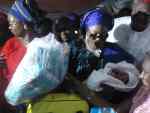Keeping on top of the health of your baby and toddler is critical for the development of your child.
One of the primary ways to do this is to ensure that you follow the immunization schedule.
Do you know what immunizations your child should receive and when? Do you know what the different injections and oral drops mean?

Immunization Schedule
Immunization is the process whereby a person is made immune or resistant to an infectious disease, typically by the administration of a vaccine. Vaccines stimulate the body’s own immune system to protect the person against subsequent infection or disease.
Immunization protects against diseases like measles, mumps, rubella, hepatitis B, polio, diphtheria, tetanus and pertussis (whooping cough), chickenpox.
There is a schedule of immunizations from birth which is helpful for a new parent to have handy. See the list below and be sure to visit your paediatrician for more information.
Vaccine |
Age |
Protects Against |
| BCG | Birth | tuberculosis (TB) |
| Hepatitis B | Birth; 10, 16 weeks |
Hepatitis B virus |
| DTaP (Pertussis/Whooping Cough) | 2, 4, 6 months, 15 – 18 months | Diphtheria, tetanus, pertussis (whooping cough) |
| MMR | 12 months, 4 – 6 years | measles, mumps and rubella viruses |
| IPV (Polio) | Birth; 6, 10, 16 weeks |
Polio |
| Rotavirus | 2, 4, 6 months | Rotavirus diarrhoea (and vomiting) |
| PCV | 2, 4,6 weeks, 12 – 15 months | against pneumococcal bacteria |
| Yellow Fever | 9 months | Yellow fever |
| Varicella | 12 months, 4 – 6 years | Chickenpox |
| Hib | 2, 4, 6 weeks, 12 – 18 months | Infections of the blood, brain, joints, or lungs (pneumonia) |
| Tdap | 11 – 12 years | Diphtheria, tetanus & pertussis (whooping cough) |
| HPV (females) | 11 -12 years | Human Papillomavirus (Females only) |
| Meningitis | 3 and 4 months | bacterium (germ) that cause meningitis |
| DTaP/IPV/Hib Booster | 4 – 5 and 13 years |
Source: Vaccineinformation
Newborn Immunity
- Newborn babies are immune to many diseases because they have antibodies they got from their mothers. However, the duration of this immunity may last only a month to about a year.
Handling Disease
- If a child is not vaccinated and is exposed to a disease germ, the child’s body may not be strong enough to fight the disease. Before vaccines, many children died from diseases that vaccines now prevent, such as whooping cough, measles, mumps and polio. Those same germs exist today, but babies are now protected by vaccines, so we do not see these diseases as often.
Babies and Toddlers Under 5
- Children under 5 are especially susceptible to disease because their immune systems have not built up the necessary defences to fight infection. By immunizing on time (by age 2), you can protect your child from disease and also protect others at school or daycare.
- Immunizing individual children also helps to protect the health of our community, especially those people who are not immunized. People who are not immunized include those who are too young to be vaccinated (e.g., children less than a year old cannot receive the measles vaccine but can be infected by the measles virus)
More on Immunization and Vaccines
- Vaccines contain the same antigens or parts of antigens that cause diseases, but the antigens in vaccines are either killed or greatly weakened. Thus, through vaccination, children develop immunity without suffering from the actual diseases that vaccines prevent.
- We don’t vaccinate just to protect our children. We also vaccinate to protect our grandchildren and their grandchildren. Our children don’t have to get smallpox shots any more because the disease no longer exists. If we keep vaccinating now, parents in the future may be able to trust that diseases like polio and meningitis won’t infect, cripple, or kill children. Vaccinations are one of the best ways to put an end to the serious effects of certain diseases.
This immunization schedule has been adapted according to the CDC and WHO (with recommendations for Nigerian Children).
Note this is a guide and each doctor will recommend their schedule based on your child, risk factors and other factors.



